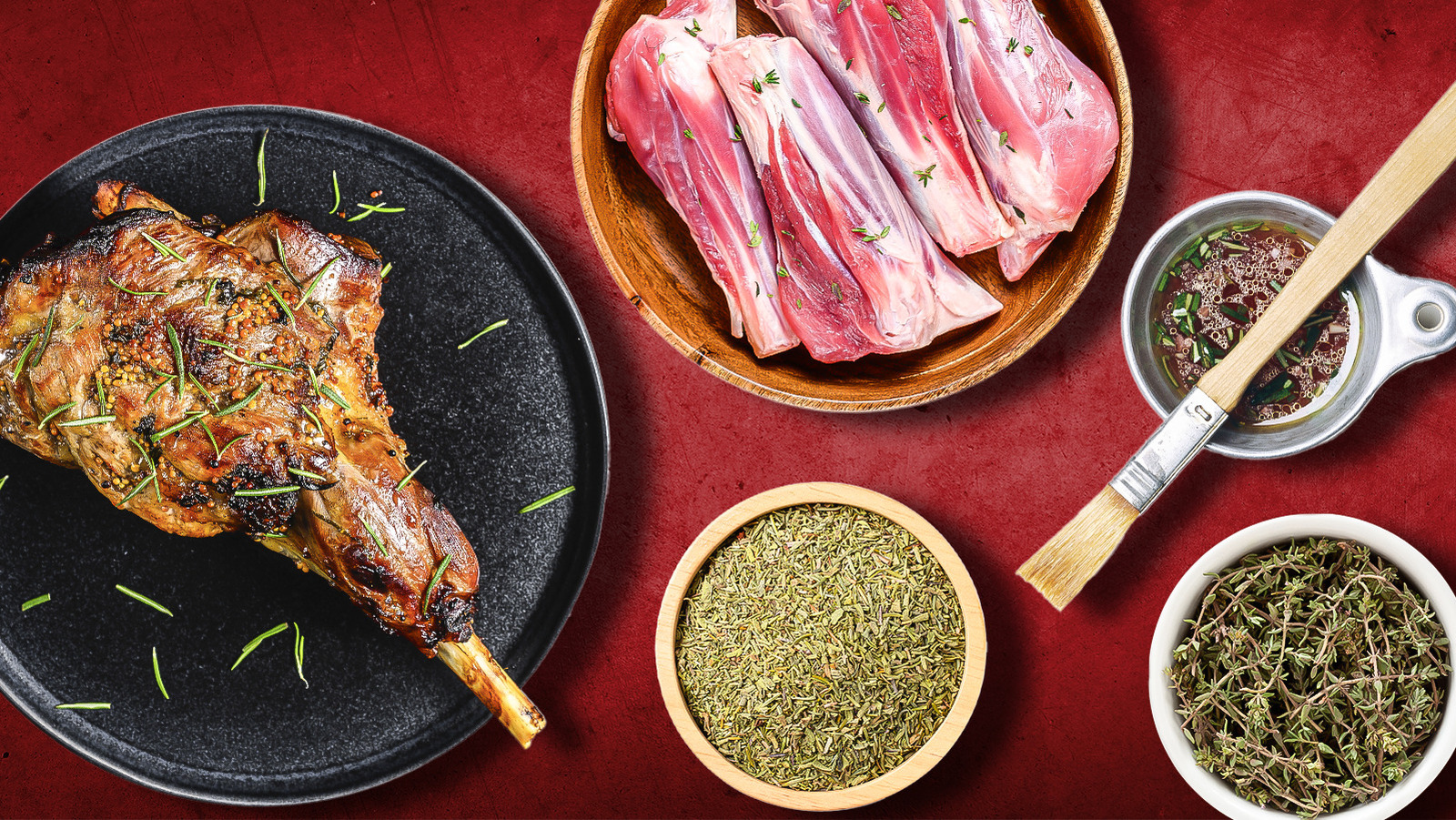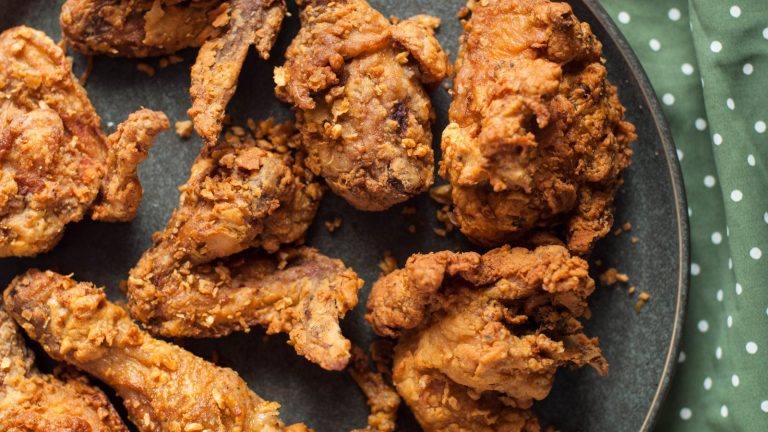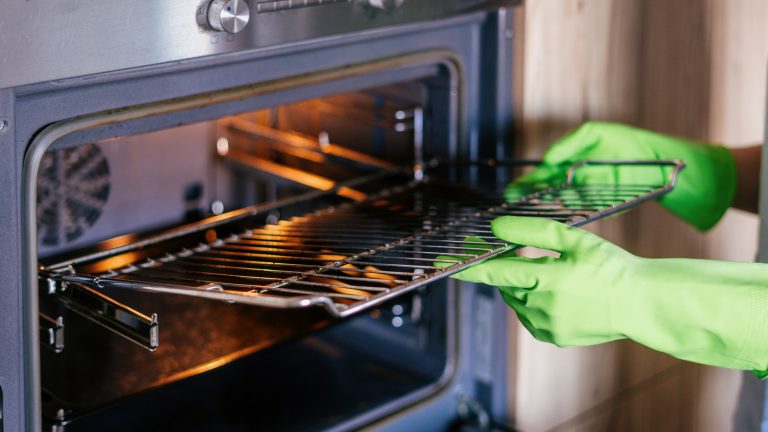We may receive a commission on purchases made from links.
Leg of lamb isn’t something that most of us cook just any old day. For many of us, it is reserved for special occasions, such as Easter, Christmas, and other holidays. For this reason, preparing it isn’t second nature. And, unlike all of those chicken cooking hacks we’ve learned from repeated practice, we may feel at a loss when it comes to cooking a leg of lamb — and ensuring it turns out just right. Plus, it’s not like a leg of lamb is the easiest recipe to prepare. There are, unfortunately, many things that could go wrong, potentially leaving you with a dry, tasteless, or simply unappealing meal to serve to your guests.
We wanted to get down to the bottom of what could go wrong so we could help you learn what not to do. To help us identify key mistakes to avoid when cooking a leg of lamb, we reached out to three professional chefs. George Duran is a celebrity chef, comedian, and entertainer; Joey Sergentakis is a Michelin-starred chef and the executive chef and co-owner of Boschetto, Allendale Social, and Charlie’s Place; and Jessie-Sierra Ross is a TV food content creator on NBC, CBS, and PBS, a cookbook author of “Seasons Around the Table,” and a food and lifestyle blogger at Straight to the Hips, Baby. Ahead, you can learn their top tips for ensuring that your special Easter meal turns out not only good, but even better than expected.
Assuming that all legs of lamb are the same
The first mistake you make when preparing a leg of lamb could occur before you even get home from the store with the meat. Many people assume that all legs of lamb are the same, and may simply pick up just anyone they find at their grocery store. However, this is far from reality. There are actually a few things you should know before buying a leg of lamb. “The major difference in lamb legs is whether they are boneless or bone-in. Bone-in lamb tends to be more flavorful, as the bone slows down the cooking time and provides a flavor boost from the marrow as it melts. Boneless lamb legs are easier to prepare, and tend to cook faster,” explains Jessie-Sierra Ross.
Beyond considering whether you want a bone-in or boneless cut, Ross also explains that it is important to pay attention to which location the leg of lamb came from. She says, “Shank end lamb legs are a bit more flavorful, but require slower cooking methods.” Conversely, she notes that the sirloin side of the leg is a more tender cut, but that also means that the meat will be fattier. If you prefer your lamb to be extra tender, Joey Sergentakis offers an additional tip to help you choose the right leg of lamb. He says, “I also prefer a younger lamb; it will most likely be more tender.”
Moving the lamb straight from the fridge to the oven
According to our experts, moving a leg of lamb directly to the oven from the fridge is a mistake you’ll want to avoid. “If you put it straight from the fridge into a hot oven, the outside can overcook while the inside stays underdone,” explains George Duran. Instead, he recommends giving the lamb between 30 and 45 minutes to come to room temperature. In addition to helping the lamb cook more evenly, Duran notes the time to warm up also “helps the meat retain its juices better.”
Jessie-Sierra Ross highlights one exception to this general rule of giving lamb time to warm up before placing it in the oven: opting for a sous vide cooking method. “Sous vide (or ‘water bath’) creates a steady cooking temperature throughout the process; an entire lamb will cook evenly to the temperature you select, as long as you give it enough time,” she explains.
Failing to trim excess fat and silverskin before cooking
While some fat is key to ensuring your lamb turns out nice and tender, Joey Sergentakis cautions against leaving all the fat on before cooking your meal. If you’ve purchased a leg of lamb before, then you may remember that there is a very thick layer of fat on one of the sides. This layer, which is located right over the muscle, is called the fell. You don’t want to cut off the entire fat cap, but you do want to remove most of it. Otherwise, according to Sergentakis, “Too much can result in a chewy or greasy bite.”
Cutting the fell off is not overly complicated. In fact, you often don’t have to actually cut it off at all. Instead, you can use the edge of a knife to lift up one of the corners before pulling the cap off. Just remember that you want to leave a thin layer, about ⅛ inch, of fat in place for a juicy finished product.
Choosing a roasting pan without a rack
There is one important thing you should consider before purchasing a roasting pan for your leg of lamb. According to George Duran, pulling one out from the cabinet or buying a new one that does not have a rack is going to be a terrible mistake. He explains, “Roasting lamb directly in the pan can cause it to sit in its juices, leading to a soggy bottom.”
Instead, always opt for a roasting pan with a rack when you’re cooking a leg of lamb. As Duran shares, “A roasting rack allows for even cooking.” Air is better able to circulate around the lamb, cooking it more evenly from all sides. This added airflow will deliver a crispy exterior instead of that sad and soggy bottom that Duran describes above. Plus, with a rack, the drippings will be ready and waiting for you if you want to make a flavorful gravy to serve with your meal.
Not seasoning it properly
Proper seasoning is key if you want your lamb to turn out absolutely scrumptious. And, fortunately, if you feel like you need a beginner’s guide to seasoning lamb, our experts offer some excellent pointers to get you started. “Lamb has a gorgeous flavor all on its own with just a simple run of salt, pepper, and minced garlic, but the sky is really the limit if you want to get creative,” shares Jessie-Sierra Ross. George Duran opts for a few additional seasonings but still keeps things relatively simple. He says, “Garlic, rosemary, thyme, and oregano are classics, but I like to mix it up with basil, parsley, and even cilantro. They enhance [the] lamb’s natural richness without overpowering it. A little lemon zest or mustard can add brightness, and a spice rub with cumin or coriander can give it an extra depth of flavor.”
If you’re looking for something even more exciting, Ross says that you can “get bold with a combination of za’atar, salt, garlic, olive oil, and lemon. Spring lamb has a unique, almost sweet taste that balances really well with savory flavoring. It’s a protein that is enjoyed throughout the world, and each culture has [its] own delicious take on this spring delicacy!” The key when deciding how to season your lamb is to consider your personal taste preferences and those of your guests. You’ll also want to think about the side dishes you plan to serve with the meal to ensure the flavors you pick complement each other well.
Not knowing how to marinate it
Marinating lamb is not required. However, if you’re going to marinate the meat, it is essential to know how to do so properly. You want to enhance its flavor, not ruin your meal. According to Jessie-Sierra Ross, “Over marinating the lamb is a common issue. Because marinades tend to use a mixture of salt, acid, and oils, the tender lamb meat can start to break down if left to sit too long.” She recommends letting the meat marinate for no more than an hour to avoid this potential issue, or even just skipping the marinating process entirely and opting to use a dry rub instead.
George Duran offers a few additional tips that can help you successfully marinate a leg of lamb. He says, “If you do marinate, make sure to pat the lamb dry before roasting so you get a nice crust instead of steaming the surface.” Duran also recommends opting for garlic and herbs instead of acidic vinegar or lemon juice that can lead to that mushy mess that Ross cautioned against.
Failing to truss a boneless leg of lamb
If you’ve never heard of trussing, Jessie-Sierra Ross offers a quick explanation to help you understand the concept. “Trussing any form of protein creates a solid ‘block’ for even cooking,” she explains. It isn’t necessary for every cut of meat, but it can make a big difference in how some cook. “I feel that trussing is only important when doing a boneless lamb. It creates a uniform shape, which promotes even cooking and makes carving easier,” explains Joey Sergentakis. Without trusting the boneless leg of lamb, portions of it may be overcooked while others are still underdone.
Trussing a leg of lamb isn’t as complicated as you may think. Start by laying the lamb on a cutting board with the inner flesh facing upwards. Add your preferred seasonings before carefully rolling the lamb up. Then, wrap some butcher’s twine around the lamb, tying slip knots as you go to create a criss-cross pattern.
Skipping the sear
As you’re deciding how to cook your leg of lamb, both George Duran and Joey Sergentakis explain that you’ll be making a grave error if you forget to sear the meat. “If you roast low and slow the whole way, you may miss that caramelized exterior,” explains Sergentakis. Your special dinner just won’t be the same, and you’re likely to have some guests who are disappointed that the outer edge of each slice is too soft.
Instead, don’t forget to sear the leg of lamb before lowering the oven temperature to let it continue cooking. As Duran explains, “Searing before roasting helps develop a flavorful crust.” There are a few different methods you can use to sear the lamb. Both, as you can probably guess, use a very high heat to develop that nice crust that both Duran and Sergentakis say is essential. One option is to preheat the broiler and place your roasting pan just a few inches below the heating element. Broil for about five minutes before flipping the lamb and broiling for a few additional minutes on the other side. After broiling, you can reduce the oven temperature.
Another option is to sear the leg of lamb in a hot pan on the stovetop. Preheat a large skillet, and then add a tablespoon or two of olive oil before searing each side of the meat for a few minutes (until a nice, brown crust develops).
Setting the oven temperature too high or too low
After that initial sear under the broiler, you’ll need to lower the oven temperature. How much lower is the question. Jessie-Sierra Ross says, “Cooking temperatures and times really depend on the size, cut, and whether your lamb leg is bone-in or boneless.” For a standard-size bone-in lamb, she recommends setting the oven to 325 degrees Fahrenheit. George Duran also sees a 325- to 350-degree oven as ideal. “Too low, and you’ll be waiting forever while the meat dries out. Too high, and the outside might burn before the inside is fully cooked. A slow, steady roast is the key to juicy, flavorful lamb,” he explains.
Joey Sergentakis prefers a slightly lower roasting temperature. After that initial sear in a 450-degree oven, he says, “I reduce the oven to 300 degrees Fahrenheit to finish cooking it gently and evenly. This method gives you the best of both worlds: a beautifully caramelized exterior and a tender, juicy interior.” While each of our experts shared a slightly different “ideal” temperature, they were all within a similar range, agreeing that you don’t want to cook lamb so slowly that it turns dry and flavorless or too quickly that it gets burnt to a crisp with a raw interior.
Under- or over-cooking the meat
When you’re excited to try a new roast leg of lamb recipe, the last thing you want is for the meat to turn out under- or over-cooked. Neither of these are very appetizing scenarios. As Jessie-Sierra Ross explains, “If the temperature is too high, you’ll end up with tough and dry lamb. But, if it’s set too low, the lamb might as well still be baa-ing.” Trying to judge lamb’s doneness based on its appearance isn’t a good approach. Not only are you running the risk of serving meat that isn’t fully cooked and safe, but according to George Duran it is too easy to make a mistake and miss the ideal pull time. “Lamb can go from juicy to dry fast!”
To avoid such devastating mistakes, Duran says, “A meat thermometer is your best friend when cooking lamb!” With a thermometer, you won’t need to guess about whether the lamb is done or not. Instead, you can set the desired temperature and pull it from the oven at precisely the right moment. Duran recommends cooking the meat to 130 to 135 degrees Fahrenheit for medium-rare or 140 to 145 degrees Fahrenheit for medium. However, remember, the meat will continue to cook once it is removed from the oven, so you’ll want to pull it out a few degrees sooner than you might think.
Carving the lamb as soon as it comes out of the oven
Did you know that you should let most meats rest after cooking? According to our experts, a leg of lamb is no exception to this rule, and skipping the rest period is a mistake you don’t want to make. “If you cut into it too soon, all those flavorful juices will run right out, leaving you with dry meat instead of a juicy, tender bite,” cautions George Duran. He explains that you can tent the roast with some aluminum foil if you don’t want it to get too cold during the resting process.
A 10- to 15-minute rest is ideal for a leg of lamb. Jessie-Sierra Ross explains the magic that is happening inside the roast during the rest. “This pause between heating and serving allows the contracted muscle of the meat to relax and to distribute its juices more evenly. This is crucial for a lean meat like lamb.” Beyond ensuring all of those delicious juices have the chance to get redistributed within the meat — instead of running out when a premature cut — Ross also explains that the resting period also allows for some carry-over cooking. “The residual heat from the initial cooking will bring the protein over to the desired final temperature,” she explains. This is why you want to pull that leg of lamb from the oven a few minutes before the oven thermometer displays your target internal temperature.
Slicing with the grain
So, now that you’ve let your leg of lamb rest for 10 or 15 minutes, you can just pick up a knife and start cutting in any direction, right? Wrong. If you cut a leg of lamb with the grain, you may be left wondering why your roast doesn’t taste all that great. According to George Duran, “If you slice with the grain, it can end up feeling a little tough and stringy.”
So, when you want to know how to cut a leg of lamb like a pro, it is crucial to slice it against the grain. Joey Sergentakis explains why this cutting direction matters so much. He says, “This shortens the muscle fibers, making each bite more tender.” So, before you start cutting, the first step must be to identify the direction of the grain. “On a leg of lamb, the grain can run in different directions depending on the section, so I suggest taking your time to find the grain while carving,” shares Sergentakis. To identify the grain, look for the muscle fibers. They should be a series of wispy lines that all go in one direction. Once you’ve identified this pattern on the leg, remember that you want to slice through all of those fibers, not in between them.
Carving thick slices
Once you’ve identified the grain and are ready to begin carving the lamb, it is important to work carefully and precisely. You want each slice to be relatively uniform to ensure a nice presentation when you serve each guest. However, those uniform pieces should not be very thick. According to George Duran, “Thinner slices make for a better texture and allow seasonings to shine through more evenly.” Ideally, each slice should be about ¼-inch thick.
There are a few other pointers that can help ensure you carve your roast properly. You don’t want to get to this point and make a mistake that could threaten your meal, do you? With a bone-in roast, the first step will be to slice the outer edges of the meat until you reach the bone. This part is relatively self-explanatory, but things get a bit more complex once you reach the bone.
Now, you’ll want to rotate the meat so that the edge of the bone where you just cut is right up against the cutting board. Then, you will want to make perpendicular cuts (going down towards the bone from above) all the way across the roast. The leg of lamb should look almost fanned out, as the base of each of these slices will still be attached to the bone. Finally, use your knife to slice right against the top of the bone to remove the slices you made.
Cutting a boneless leg of lamb will be less involved. After removing the twine, you can carefully slice it with a sharp knife. Again, take care to keep your slices very thin.





